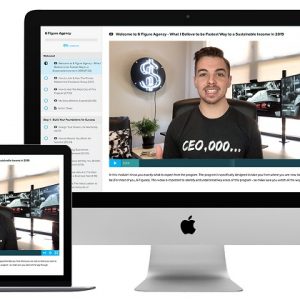Mastering the Cold Call – Grant Cardone
$497.00 Original price was: $497.00.$15.00Current price is: $15.00.
Mastering the Cold Call is not just about making phone calls; it’s about mastering the art of connection, persuasion, and ultimately, driving sales success. This article delves into the core principles and strategies to transform your cold calling efforts into a revenue-generating machine.
Table of Contents
The Untapped Potential of Cold Calling in Modern Sales

In an era dominated by digital marketing and inbound leads, the cold call might seem like a relic of the past. However, dismissing its potential is a grave mistake. The program asserts that the cold call remains the single most powerful and effective way for a salesperson to exceed their quota.
Why Cold Calling Still Reigns Supreme
It’s easy to get caught up in the allure of shiny new marketing technologies. However, the core principle of sales remains the same: connecting with potential customers and convincing them of the value you offer. Cold calling, when done right, provides a direct line to your target audience, cutting through the noise and allowing for immediate engagement. It empowers salespeople to take control of their success. Instead of waiting for leads to trickle in, they can proactively seek out opportunities and drive revenue.
This proactive approach is particularly crucial for startups with limited marketing budgets. Cold calling enables them to share their ideas, build relationships, and generate sales without relying on expensive advertising campaigns. It allows for immediate feedback and adjustments to your messaging, something that marketing campaigns often lack. You can gauge interest, identify pain points, and tailor your pitch in real-time, leading to more effective conversations and higher conversion rates.
The misconception that cold calling is outdated often stems from a lack of proper training and strategy. Many salespeople approach cold calling with fear and trepidation, resulting in lackluster results. With the right knowledge, skills, and mindset, anyone can transform themselves into a cold calling master, capable of generating leads, closing deals, and exceeding their sales targets. This mastery translates into a significant advantage for organizations. A skilled cold caller becomes an invaluable asset, capable of driving revenue growth and expanding market reach.
Debunking the Myths and Overcoming the Aversion
Let’s face it: cold calling can be intimidating. The fear of rejection, the awkwardness of interrupting someone’s day, and the perceived difficulty of breaking through to decision-makers are all valid concerns. However, these fears can be overcome with a structured approach and a shift in mindset. The common aversion to cold calling can be addressed with the structured training mentioned in the outline. Mastering the Cold Call addresses the common reluctance to engage in this activity, promising to boost confidence and sales figures, and eliminate feelings of rejection through its comprehensive program.
One of the biggest myths surrounding cold calling is that it’s about manipulation and high-pressure tactics. In reality, successful cold calling is about building genuine connections and providing value to the prospect. It’s about understanding their needs, offering solutions, and establishing trust. Another misconception is that cold calling is a numbers game. While quantity matters to some extent, quality trumps quantity every time. Bombarding prospects with generic pitches is unlikely to yield positive results. Instead, focus on targeted outreach, personalized messaging, and engaging in meaningful conversations.
The ROI of Mastering the Cold Call
The return on investment (ROI) of mastering the cold call is undeniable. By honing your skills and developing a strategic approach, you can significantly increase your sales performance and income potential. The program is designed to empower individuals and organizations to leverage cold calling for increased sales and business growth.
Here are just a few of the benefits you can expect:
- Increased Lead Generation: Generate a steady stream of qualified leads, expanding your sales pipeline and creating new opportunities.
- Higher Conversion Rates: Convert more leads into paying customers by effectively communicating your value proposition and addressing their needs.
- Accelerated Sales Cycles: Shorten the time it takes to close deals by proactively engaging with prospects and moving them through the sales process.
- Improved Sales Performance: Exceed your sales targets and achieve financial success through consistent cold calling efforts.
- Enhanced Customer Relationships: Build stronger relationships with your customers by understanding their needs and providing exceptional service.
Building a Foundation for Cold Calling Success: Skills and Knowledge
To become a master of the cold call, you need more than just enthusiasm. You need a solid foundation of skills and knowledge that will enable you to navigate the challenges and maximize your results. The “What You’ll Learn” section underscores the program’s emphasis on imparting specific, actionable skills for practical outcomes such as scripting, objection handling, improved appointment and close rates, gatekeeper navigation, strategic questioning, income targeting, and process optimization.
Crafting Compelling Scripts that Convert
Your script is your roadmap for a successful cold call. It provides a framework for the conversation, ensures that you cover all the key points, and helps you stay on track even when faced with objections. However, a script should not be a rigid, robotic recitation. It should be a flexible guide that allows you to adapt to the prospect’s needs and engage in a natural conversation.
Start by clearly defining your target audience and understanding their pain points. What challenges are they facing? What solutions are they seeking? Then, craft a script that addresses these pain points and highlights the value you offer. Your script should include a compelling opening statement that grabs the prospect’s attention and makes them want to listen. It should also include a clear and concise explanation of your product or service, focusing on the benefits it provides. Finally, it should include a strong call to action that prompts the prospect to take the next step, such as scheduling a meeting or requesting a demo.
Here’s an example script outline:
- Greeting: Introduce yourself and your company.
- Value Proposition: Briefly explain the value you offer and how it addresses the prospect’s pain points.
- Qualifying Questions: Ask questions to determine if the prospect is a good fit for your product or service.
- Benefit Statement: Highlight the specific benefits that the prospect would receive from using your product or service.
- Call to Action: Ask for the next step, such as scheduling a meeting or requesting a demo.
Remember to practice your script repeatedly to ensure that you deliver it confidently and naturally. Don’t be afraid to deviate from the script when necessary to engage in a more meaningful conversation.
Mastering Objection Handling: Turning “No” into “Yes”
Objections are an inevitable part of cold calling. It’s rare to find a prospect who is immediately ready to buy. However, objections are not necessarily roadblocks. They are opportunities to address the prospect’s concerns, provide additional information, and ultimately, turn a “no” into a “yes.”
The program places significant emphasis on objection handling, with a dedicated module covering common objections such as “Not Interested,” “I Am Busy,” “Send Me Some Information,” and “No Budget.” When handling objections, it’s crucial to listen attentively to the prospect and understand their underlying concerns. Don’t interrupt them or become defensive. Instead, acknowledge their concerns and show that you understand their perspective. Then, provide a clear and concise response that addresses their concerns and highlights the value you offer.
Here are a few examples of common objections and how to handle them:
- “Not Interested”: “I understand you may not be actively looking for a solution like ours right now, but I believe it could significantly improve your [specific area of business]. Would you be open to a quick 5-minute call to explore how?”
- “I Am Busy”: “I certainly respect your time. How about we schedule a brief call for [suggest a specific time and date]?”
- “Send Me Some Information”: “Absolutely. In addition to sending you information, I’d like to schedule a quick follow-up call to answer any questions you may have. Would that work for you?”
- “No Budget”: “Many of our clients initially had the same concerns. However, after implementing our solution, they saw a significant return on investment and actually saved money in the long run. Would you be open to exploring how that could work for you?”
Remember to always remain professional and respectful, even when faced with difficult objections. Your goal is to build a relationship with the prospect and demonstrate your value, not to win an argument.
Conquering the Gatekeeper: Your Passage to Decision-Makers
Gatekeepers are the gatekeepers of information and access within an organization. They can be your biggest obstacle or your greatest ally, depending on how you approach them. The program provides specific strategies for navigating past the gatekeeper, including “Act the Part,” “Kill the Small Talk until you need it,” and “The Power Greeting for the Gatekeeper.”
When interacting with a gatekeeper, it’s essential to be polite, professional, and respectful. Treat them as valuable members of the team, not as obstacles to be overcome. Introduce yourself clearly and state the purpose of your call. If possible, try to establish a rapport with the gatekeeper by engaging in brief, friendly conversation. Be prepared to answer their questions and provide them with the information they need to make a decision.
Here are a few tips for getting past the gatekeeper:
- Use a confident and professional tone of voice.
- Know the decision-maker’s name and title.
- Have a clear and concise reason for calling.
- Be prepared to answer questions about your company and product.
- Don’t be afraid to ask for help.
- Be persistent but not pushy.
Structuring Your Approach: Mastering the Cold Call Process
Mastering the Cold Call involves more than just picking up the phone and dialing. It requires a structured approach that maximizes your chances of success. The program highlights the importance of mastering the PERFECT cold call process: Greeting, BIG Claim, Qualify/Fact Find, and Close.
The Power of a Strong Opening: Greeting and BIG Claim
The first few seconds of your cold call are critical. You need to grab the prospect’s attention and make them want to listen to what you have to say. Your greeting should be clear, concise, and professional.
Start by introducing yourself and your company. Then, immediately follow up with a “BIG Claim” that highlights the value you offer and addresses the prospect’s pain points. This claim should be compelling enough to pique their interest and make them want to learn more. For example, instead of saying “We offer a software solution,” you could say “We help businesses like yours increase their sales by 20% in just three months.”
Asking the Right Questions: Qualifying and Fact-Finding
Once you have the prospect’s attention, you need to qualify them to determine if they are a good fit for your product or service. This involves asking strategic questions that reveal their needs, challenges, and budget. The program emphasizes strategic questioning, highlighting the use of questions that secure appointments and “Magic Questions” that advance the sales process.
Here are a few examples of qualifying questions:
- “What are your biggest challenges in [specific area of business]?”
- “What are your current goals for [specific area of business]?”
- “What is your budget for [specific area of business]?”
- “What are the key priorities for your team over the next year?”
- What is the biggest problem you are facing right now?
By asking the right questions, you can quickly determine if the prospect is a good fit for your product or service and tailor your pitch accordingly. If the prospect is not a good fit, don’t waste your time trying to convince them otherwise. Politely thank them for their time and move on to the next call.
Sealing the Deal: The Art of the Close
The close is the culmination of your cold calling efforts. It’s the point where you ask the prospect to take the next step, such as scheduling a meeting, requesting a demo, or making a purchase. The program focuses on strategies to double both appointment and close rates.
Closing a cold call requires confidence, persistence, and a clear understanding of the prospect’s needs. Before asking for the close, reiterate the value you offer and address any remaining concerns. Then, make a clear and concise request for the next step.
Here are a few examples of closing statements:
- “Based on our conversation, I believe that our solution could significantly improve your [specific area of business]. Would you be open to scheduling a brief demo to see how it works?”
- “I’m confident that we can help you achieve your goals for [specific area of business]. Let’s schedule a meeting to discuss your specific needs and how we can help.”
- “I’m excited about the potential for us to work together. Are you ready to get started?”
If the prospect is hesitant, don’t be afraid to address their concerns and offer additional information. However, don’t become pushy or aggressive. The goal is to build a relationship with the prospect and earn their trust, not to force them into making a decision they’re not comfortable with.
Cultivating Success: Preparation, Practice, and Daily Rituals
Mastering the Cold Call requires more than just technical skills. It also requires diligent preparation, consistent practice, and a strong commitment to daily success rituals.
Preparing for Success: Defining Contacts, Doing the Math, and Building Your List
Before you pick up the phone, you need to be prepared. This involves defining your target audience, doing the math to determine how many calls you need to make, and building a list of qualified prospects. Defining contacts, doing the math (call calculations), building a list, call preparation that guarantees success, and scripting are all part of the “Preparation” process outlined in the program.
Start by clearly defining your ideal customer profile. What are their demographics, industry, and company size? What are their pain points and challenges? Once you have a clear understanding of your target audience, you can begin building a list of qualified prospects. Use online resources such as LinkedIn, industry directories, and company websites to find potential leads. Be sure to gather as much information as possible about each prospect, including their name, title, contact information, and company details.
Next, do the math to determine how many calls you need to make to achieve your sales goals. This involves calculating your conversion rates, average deal size, and sales cycle length. For example, if you want to close 10 deals per month and your conversion rate is 10%, you will need to generate 100 leads. If it takes 10 cold calls to generate one lead, you will need to make 1,000 cold calls per month.
Honing Your Skills: The Importance of Role-Playing
Role-playing is an essential part of mastering the cold call. It allows you to practice your skills, refine your script, and build your confidence in a safe and supportive environment. Practicing role play everyday is mentioned as an advice.
Find a colleague, friend, or mentor who is willing to role-play with you. Take turns playing the roles of the salesperson and the prospect. Practice handling different scenarios, such as handling objections, answering questions, and closing the deal. Record your role-playing sessions so you can review them later and identify areas for improvement.
Daily Rituals for Peak Performance:
Consistency is key to success in cold calling. To achieve consistent results, you need to establish daily rituals that support your performance and keep you motivated. A dedicated module outlines routines for Inside Sales professionals, including getting up early, working out, focusing on the prize, call calculations, training and role play, cleaning your space, making a list of 5, and finding your music.
Here are a few daily rituals you can incorporate into your routine:
- Get Up Early: Start your day with a clear mind and a positive attitude.
- Workout: Exercise helps to reduce stress, boost energy levels, and improve focus.
- Get Focused: Visualize your goals and remind yourself of why you’re doing what you’re doing.
- KNOW Your Call Calculations: Review your call calculations to stay on track with your sales goals.
- Start Your Day with Training and Role Play: Sharpen your skills and build your confidence before you start making calls.
- Clean Your Space: A clean and organized workspace can help you to focus and be more productive.
- Make Your List of 5: Identify the five most important tasks you need to accomplish each day.
- Find Your Music: Listen to upbeat music to get yourself motivated and pumped up for your calls.
Recognition and Reinforcement: Celebrating Your Achievements
Recognition and reinforcement are essential for maintaining motivation and building a positive attitude towards cold calling. The program provides tangible markers of achievement, reinforcing the program’s value and credibility.
The Power of a Badge and Certificate
Upon completion of the program, participants receive a badge that can be hosted on your website, email signature, and LinkedIn profile, as well as a digital, printable certificate of completion for framing. These credentials serve as tangible proof of your skills and expertise, enhancing your credibility and demonstrating your commitment to professional development.
Displaying your badge and certificate can also help you attract new clients and opportunities. Potential customers are more likely to trust and work with someone who has demonstrated a commitment to learning and mastering their craft.
Leveraging Status and Recognition
Completing a Cardone University program provides you with status and recognition within the sales community. This recognition can help you stand out from the crowd, build your network, and advance your career.
By leveraging your status and recognition, you can position yourself as a master of the cold call and attract new opportunities. Share your accomplishments on social media, attend industry events, and network with other sales professionals.
Conclusion
Mastering the Cold Call isn’t about antiquated telemarketing; it’s a dynamic strategy for proactive sales and business growth. By embracing structured training, developing essential skills like scripting and objection handling, optimizing the cold call process, and committing to consistent preparation and practice, you can overcome the aversion to cold calling and unlock its unparalleled potential. The rewards are substantial: increased leads, higher conversion rates, and ultimately, the achievement of your income targets and sales goals.
Sales Page:_https://store.grantcardone.com/collections/cardoneuniversity/products/master-the-cold-call-training
Related products
Marketing











